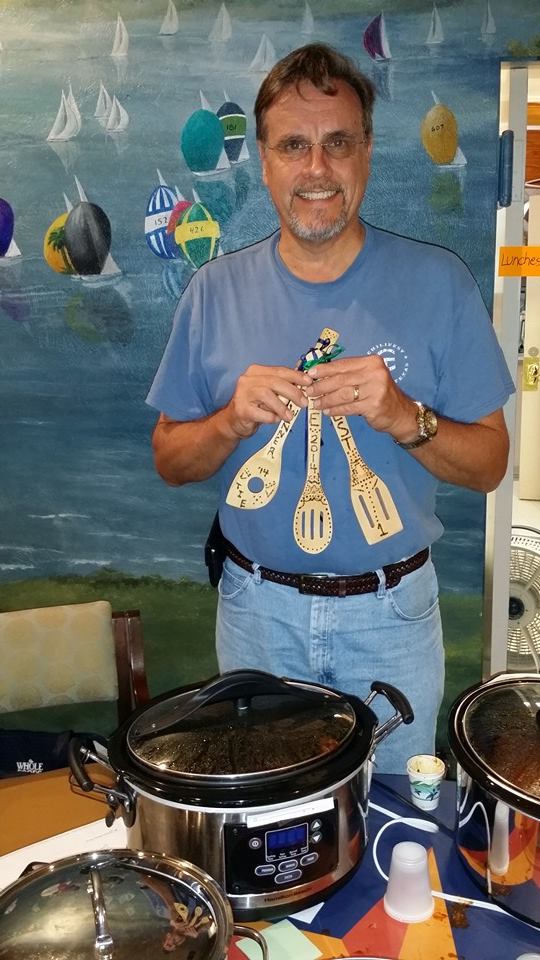Panther Creek Heat, Winner of 2014 Dallas Corinthian Yacht Club Terlingua-in-Exile Chili Cook Off
Yesterday I entered my very first cooking competition, the Dallas Corinthian Yacht Club’s Terlingua-in-Exhile Chili Cook Off. My usual chili is pretty good, but for competition I wanted to take my game up a few notches. I consulted the all-seeing Google and found a number of really great recipes (along with some really weak recipes that I will not link), A Bowl of Red is supposed to be awesome rather than wimpy. And let’s agree not to talk about beans.
This recipe is heavily based on Lisa Fain’s Seven-Chile Texas Chili recipe, but I added some ideas from a couple of other sources too:
http://www.homesicktexan.com/2006/10/how-to-make-pot-of-texas-red-part-one_15.html
http://www.homesicktexan.com/2006/10/how-to-make-pot-of-texas-red-part-two_18.html
http://www.esquire.com/features/guy-food/texas-chili-recipe-ll-1208
http://www.seriouseats.com/2011/11/real-texas-chili-con-carne.html (Good grief, this one includes beans! That ain’t chili. Good ideas though!)
A word of warning: this is not your week-day chile. It takes more preparation and longer cooking than most chili recipes you will find. I started around noon and ran out the door with it at about 4:15pm, barely making it to the competition in time at 4:30pm.
Panther Creek Heat
Winner of 2014 Dallas Corinthian Yacht Club Terlingua-in-Exile Chili Cookoff
Ingredients
6 dried ancho chiles (All of the chiles I used were from Pendery’s)
2 dried pasillia chiles
2 dried mulatto chiles
2 dried guajillo chiles *
2 dried chipotle chiles (I did not have this so I used 1/2 cup chipotle flakes)
4 dried chiles de arbol
about 3 or 4 cups of water
1 Tbsp extra virgin olive oil
6 pieces beef bacon
4 pounds chili-ground beef (I used Burgundy Pasture Beef‘s grass-fed, chili-ground beef)
2 medium red onions diced
6 cloves garlic, minced
1 shot espresso
1 Tbsp grated 70% chocolate
1 tsp Marmite
2 tsp Soy Sauce
2 filets of anchovy
3 cups chicken broth
2 pkg Savory Choice beef broth concentrate
2 tsp dried oregano
1/2 tsp ground cinnamon
1/2 tsp ground clove
1/2 tsp ground allspice
1/2 tsp ground coriander
1/2 tsp ground turmeric
1/2 tsp ground black pepper
4 dried pequin chiles
1 tsp fine sea salt
1 tsp ground cumin
1 shot sour mash whiskey
2 Tbsp fine ground masa harina
Procedure
Heat your oven to 200 degrees. That sounds low, but we will be simmering the chile for 3 hours at this low temperature.
Cut off stems from dried chiles, cut open, remove seeds and any pith. It is Ok if you leave a few seeds. In a dry skillet heated to medium-high, toast all the chiles, except the pequin chiles, in the pan. Turn the chiles every 10 or 15 seconds to prevent them from burning. When the chiles begin to puff, pour in enough water to cover the chiles. When the water boils, turn off the heat and let the chiles soak for about 30 minutes.
Put olive oil in a large dutch oven or other oven-safe pot, turn on heat to medium and fry the beef bacon until slightly crispy. Drain the bacon on paper towels. Leave the grease in the pot.
Cook the ground beef, browning the outside before breaking into medium clumps. You may want to do this in two batches, 2 pounds at a time. Scoop the meat out of the pot with a slotted spoon, allowing most of the fat to drain back into the pot. Discard all but about 1 Tbsp of fat. Soften the onions in the fat on medium heat until they are translucent. Leave the heat on. Mix the miced garlic into the onions and put the following herbs and spices into the mixture:
cinnamon, oregano, clove, allspice, coriander, turmeric, salt and black pepper.
(Do not put the cumin in yet! It will become too bitter if it cooks to long.)
Chop up the anchovy filets. Put the anchovies, Marmite, and soy sauce in with the onion mixture. Chop the beef bacon, and put both it and the browned ground beef in the onion mixture. Pour in the chicken broth and the beef broth concentrate. Stir well. Bring to boil and then set to simmer.
When the chiles have finished soaking, drain through a fine colander and discard the now-bitter water. Put the chiles in a blender or large food processor with 1 cup of water. Put in the 4 pequin chiles and puree. There may be a few bits that do not liquefy but that will be all right.
Pour the chile puree into the beef and onion mixture. Pour in the shot of espresso and put in the grated chocolate and stir well. When this mix starts to bubble, turn off the range top, put the lid on the pot, and transfer the lidded pot to the oven.
Let this ambrosia simmer in the oven for 3 hours.
Remove the pot from the oven at about 3 hours and put back on low range heat. Put the cumin in the chili and stir well. Thoroughly mix the masa harina with about 3 Tablespoons of warm water. Mix the masa harina paste into the chili and stir well. Pour the whiskey shot into the chili and stir. Salt to taste (it probably will not need any though with the salt and anchovies.). Let the chili heat for about 15 to 30 minutes to allow the final ingredients to blend flavors with the chili.
Proudly serve with corn bread, pinto beans on the side, chopped white onions, grated cheddar cheese, and seeded and chopped jalapenos.
So how did I do?
Overall winner! More importantly, I got to have some awesome chili!
(* Update 11/3/2014 I just noticed that the 2 guajillo chiles were not in the recipe above, now corrected.)

